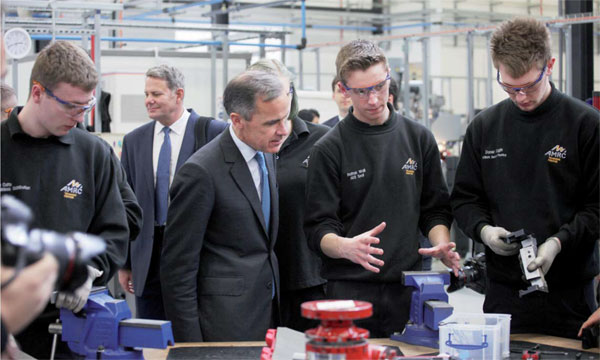A powerful connection for Britain
Updated: 2015-04-03 07:31
By Cecily Liu(China Daily Europe)
|
|||||||||||
A UK research center wants to harness China's third-generation nuclear technology
A research center led by a pair of British universities is looking to connect China's nuclear technology with United Kingdom firms to create what they say will be safe, efficient and cost-effective power plants.
The Nuclear Advanced Manufacturing Research Center, led by the University of Sheffield and the University of Manchester, is in the process of setting up a local supply chain to utilize China's third-generation nuclear technology in UK power plants.
|
Mark Carney (third from right), the governor of the Bank of England, talks to apprentices at the AMRC Training Center. Photos provided to China Daily |
The center is also looking to help China build a more efficient and cost-effective generation of nuclear power to export around the world, says Sir Keith Burnett, vice-chancellor of the University of Sheffield.
"We cannot just bring Chinese nuclear technology to the UK. We need to work with our Chinese partners to create a combined British product which we can export around the world," Burnett says.
China's nuclear industry hit a milestone in 2013 when it agreed to invest in the UK's Hinkley Point C project. Led by France's EDF Group, two nuclear power stations will be built at a cost of 164 billion pounds ($243.6 billion; 225 billion euros). The plant is scheduled to start operating in 2023 if built on time.
EDF would have majority control of about half the equity. China General Nuclear Power Group and China National Nuclear Corp would have a combined stake of 30 to 40 percent, and Areva, a French nuclear firm, would have the remaining 10 percent.
As part of the agreement, EDF will support the two Chinese nuclear companies in the development of a new atomic plant at Bradwell B, the site of a partially decommissioned nuclear power station in the UK. The new plant will be majority owned by the Chinese investors and use a significant amount of Chinese nuclear technology.
"China's investment to help EDF to build Hinkley Point C is greatly welcomed, as we need zero carbon energy in the UK and we have a legal commitment to decarbonize. But there is also a strong feeling that developing nuclear energy with Chinese influence and technology is a good thing for the UK," Burnett says.
Burnett says his team is preparing the supply chain that will bring China's third-generation nuclear technology into the UK.
He says most of the manufacturers of components needed for the plants will be from Sheffield, many of whom already have stable relationships with the Nuclear AMRC. Although the civil engineering and construction will be sourced from China, the meters, tubing and power systems can be sourced from the UK.

"We want to make the Nuclear AMRC a center for developing this supply chain, and also testing prototypes and materials from the suppliers to make sure they are coherent with what the Chinese nuclear companies are expecting," Burnett says.
Nuclear ARMC was founded in 2009 with the goal of combining the knowledge and expertise of manufacturing companies and universities. The center's lead industrial partner is Rolls-Royce. Other founding partners are Areva, Westinghouse, Sheffield Forgemasters and Tata Steel.
The Nuclear AMRC established its facility in the Advanced Manufacturing Park in October 2011, with the official launch in May 2012. Queen Elizabeth II attended the facility's groundbreaking.
Burnett says one of the center's key roles in helping introduce Chinese nuclear technology to the UK is testing the safety of the technology, which will be completed in partnership with the UK's National Nuclear Lab.
The Chinese nuclear technology to be introduced to the UK will be Hualong One, a third-generation nuclear reactor designed last year developed by the China General Nuclear and China National Nuclear companies.
In December, Hualong One's core technology, the ACP1000 technology by CNNC, passed the Generic Reactor Safety Review by the International Atomic Energy Agency, a milestone that puts China on a level playing field with Western countries in bids for international projects.
Burnett says his team believes in the quality of China's third-generation technology and hopes to work with Chinese partners to develop even better technology going forward, especially in the area of small modular nuclear reactors that have great potential for use in the UK and around the world.
Burnett says one reason behind China's high-quality nuclear industry is the nation's strong political support.
"The pace of doing things in China is significantly different. In a capital economy, people are worried about the price of investment all the time, so they may not do anything. We need the Chinese nuclear industry to challenge us with the pace," he says.
Cost-efficiency is another big advantage in China's nuclear industry, Burnett says.
"China has a well-trained nuclear industry," he says. "There is a real admiration for the pace and style that China has developed with its technology. It is important that we develop a good working relationship with China on all levels by helping them to source a UK supply chain, and this includes relationships between our engineers, scientists and businesspeople," he says.
One way he believes Nuclear AMRC can help advance Chinese nuclear technology is by applying efficient manufacturing techniques from the UK's aerospace industry.
"We can bring the most advanced ideas in manufacturing to the nuclear industry, and these modern manufacturing techniques have already proved to improve time and optimize capacity with firms like Airbus and Rolls Royce.
"We can trace the components in the manufacturing process and find the best way to fit them together and provide quality assurance for the manufacturing process."
He says a sound supply chain for Chinese nuclear technology could generate around 1 billion pounds of revenue in Sheffield over five to six years, with an additional 5 billion pounds of revenue generated in the UK.
"By joining hands with China we will have a product that will sell across the world, which will be cheaper, better and safer," he says.
The current fleet of nuclear power plants in the UK is set to retire in the next 20 to 30 years. Given how long it takes to build a nuclear power plant, there is an urgent need to develop and construct a new crop of nuclear plants.
Keith Howells, chairman of Mott MacDonald, an engineering consultancy, says Chinese investment can play a key role in achieving this goal.
"According to the latest survey, China will invest over 100 billion pounds in Britain in energy, transport, buildings, water, properties, agriculture, health and education. Chinese investment is indeed a game changer for the UK."
Howells says building a nuclear power plant requires a lot of capital and it needs to comply with the most stringent safety and environmental standards.
"Mott MacDonald can help Chinese nuclear developers and operators to understand and meet the UK regulatory requirements by working together. Our engineers and consultants can articulate what the British regulators want from Chinese engineers and convert Chinese design to British standards and codes."
cecily.liu@chinadaily.com.cn
(China Daily European Weekly 04/03/2015 page20)
Today's Top News
54 dead after Russian trawler sinks in ocean
Death toll rises to 147 in Kenya university attack
Dozens killed in Kenyan university attack
Video of final seconds aboard Germanwings plane discovered
British Prince Harry reports for duty in Australia next week
Chinese World War II veterans to receive medals from Russia
Lufthansa insurers set aside $300 mln over crash
Sarkozy makes political comeback
Hot Topics
Lunar probe , China growth forecasts, Emission rules get tougher, China seen through 'colored lens', International board,
Editor's Picks

|

|

|

|

|

|







